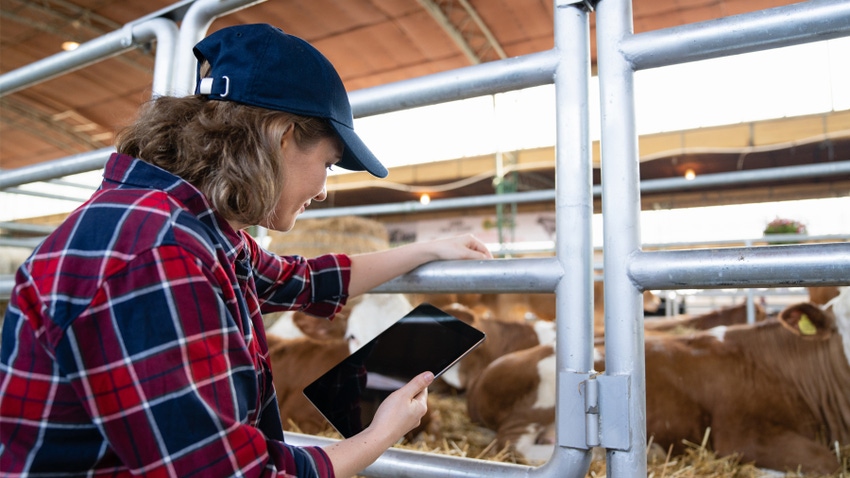
The “red notebook” has been an indispensable way to track herd records for generations of cattlemen. But today’s software technology pioneers are creating real solutions that can track those same records and provide solutions that can save time and money for the ranch.
A panel of experts discussed these solutions during the 2023 Cattlemen’s College in February, including John Fargher, co-founder of AgriWebb; James Maiocco, chief operating officer of Barn2Door; and Justin Sexten, head of industry networks and partnerships for Performance Livestock, Zoetis.
It’s easy to get overwhelmed at the options available to cattlemen, but Sexten offered four aspects of the business side of ranching that technology may be able to help.
“First, cost control, well over 50% of your profitability lies in reduction of your costs,” Sexten said. “Next is enhancing your animals’ performance and finding opportunities for marketing. And the one that entices people to adopt technology more, is making their lives easier.”
He said technology solutions can help cattlemen make the most out of their limited feed resources in a drought or help them better manage their available range resources. For others, who may be balancing off-farm jobs with ranching duties, technology may help boost efficiency and make their chores easier and take less time.
Sexton explained that cattlemen have been writing down data points for years in their stacks of red notebooks — from tracking herd records, to feeding records and more. But they haven’t really had the ability to see that data in a format that can help them make valuable business decisions. New apps today can do just that and more.
Market opportunities
Some technology can help cattlemen discover new market opportunities. Maiocco explained that Barn2Door is an app that helps cattlemen connect to consumers directly, allowing them to own their own brands and build their own relationships with customers.
By skipping the sale barn and going direct to market, they can drive their profits. But making that leap has been difficult for many who don’t have the time or the know-how to market their own beef through traditional channels.
What apps such as Barn2Door can do is help connect cattlemen to customers shopping online for their locally raised beef.
“Three out of 5 Americans buy their groceries online now, and that didn’t stop after the pandemic,” Maiocco said. “It just accelerated and solidified that trajectory of the trend. Convenience wins.”
If direct-to-consumer marketing is an opportunity you’ve identified for your ranch, apps like Barn2Door can help you reach the 82% of Americans who want to buy local, but just don’t know a local rancher.
“Instead of selling an animal for $600 to $800 a head at the sale barn, you might be selling it for $3,500 a head now when you’re selling direct to a consumer, or direct to grocers or chefs,” Maiocco said.
Benchmarking data
The panelists stress that their tools all ensure that the data collected belongs to the user.
However, by anonymizing and aggregating data from users, technology companies can also provide cattlemen with benchmarking metrics to help them make decisions.
For example, Fargher explained that AgriWebb is a ranching management platform that has digitized the notebook of yesterday, collecting that animal information, pasture and grass information, animal health records, nutrition, and more. Then, through aggregated and anonymization, users get insights into larger macro opportunities for their operation type, or their region, or more.
“Every rancher out there wants to know how they’re doing against similar ranches in their geography,” Fargher said. “Think about how knowing how you compare to other ranches in stocking rates, fertility or more could help you see ways you could improve. The power of digitizing information allows us to see all these macro-opportunities that don’t exist if we’re just running in an analog world.”
Change in behavior
Adopting technology solutions requires two things — that the technology is simple to use and that those using it follow through and continue to use it.
It’s not a generational thing, but rather an attitude, the panelists agreed. Getting over the hurdle of moving from a notebook to a digital format may be as simple as showing someone how digitizing all the knowledge they have about their herd and their land can help pass the ranching operation on to the next generation, so they have the opportunity to continue the business.
Sexten added that for younger generations trying to find their place returning to the family cattle business, data technology could be that place.
He said by taking on the commitment to managing and implementing the technology in the operation, that shows a young person wants to have some ownership and an area that they can manage in the business.
“It provides a way you can demonstrate you have added value to the operation, and not just the expectation that you come home and be part of it,” he said.
Read more about:
Record keepingAbout the Author(s)
You May Also Like






